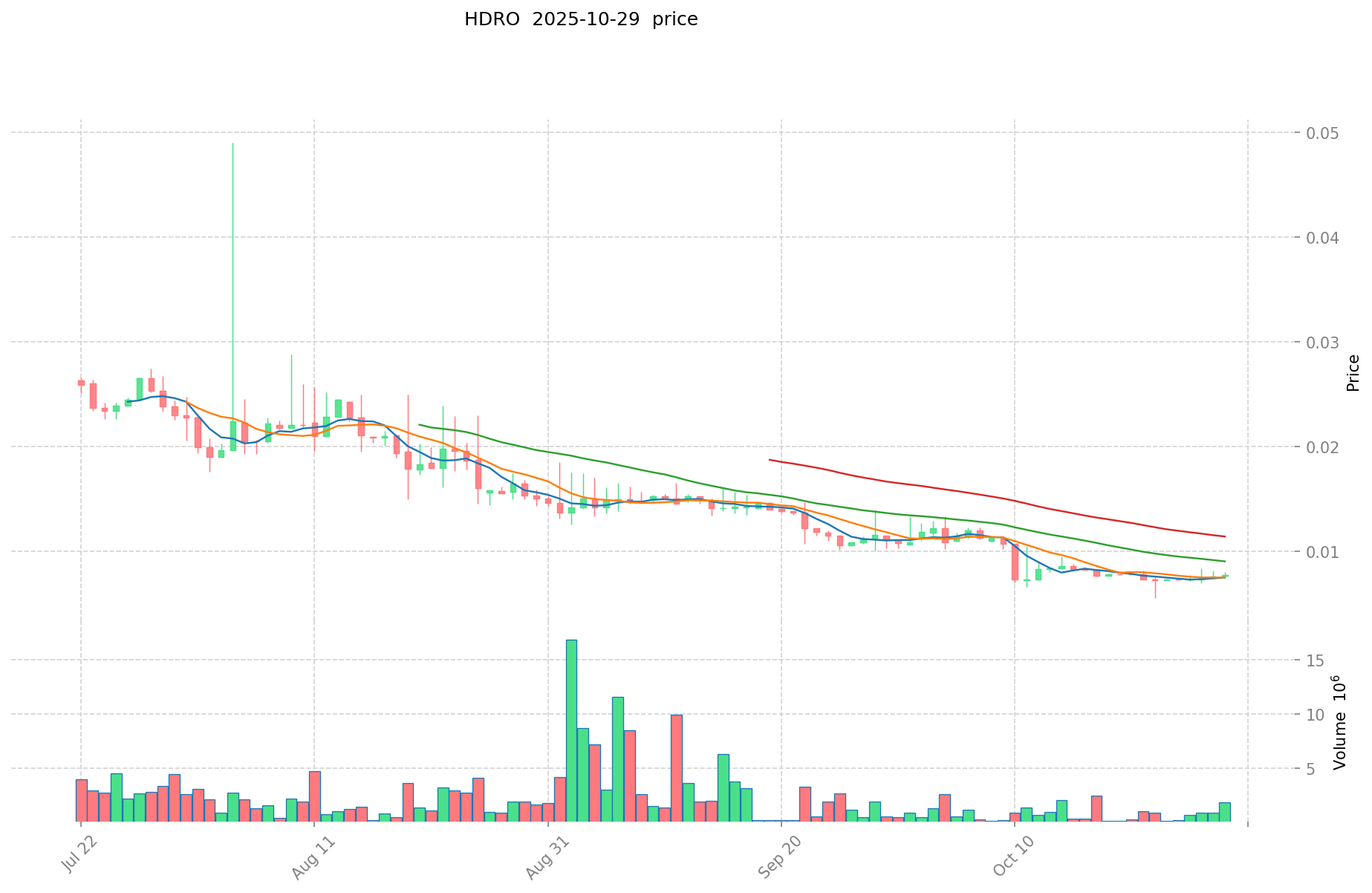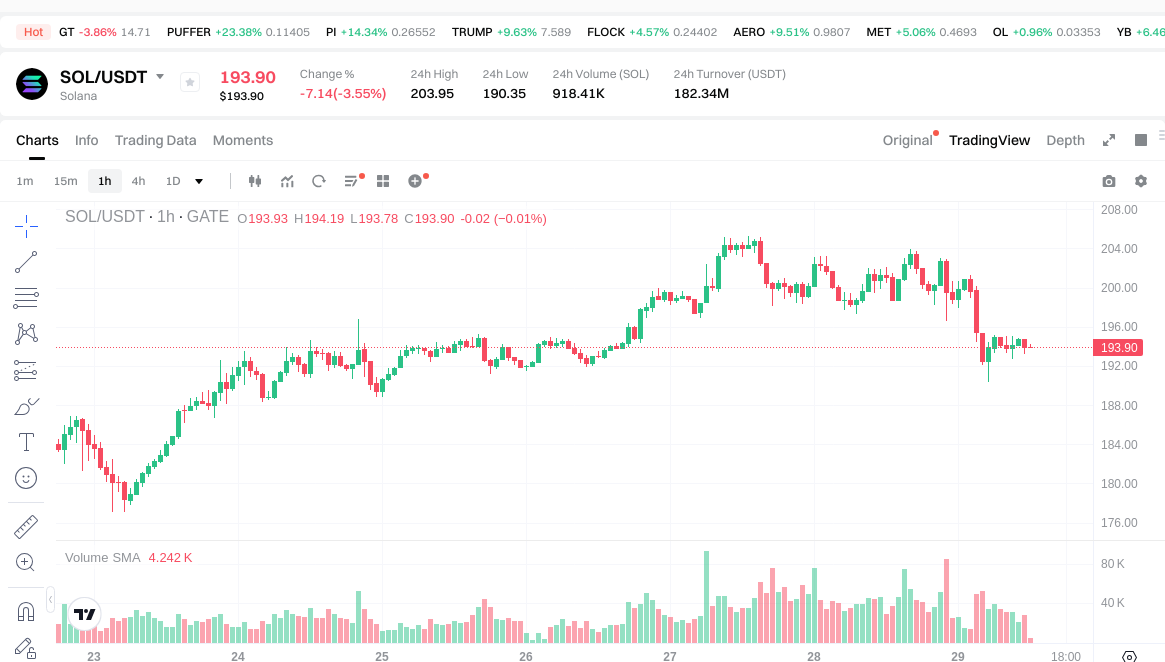HDRO vs SOL: Comparing Two Promising Blockchain Ecosystems for DeFi Applications
Introduction: Investment Comparison of HDRO vs SOL
In the cryptocurrency market, the comparison between Hydro Protocol vs Solana has been an unavoidable topic for investors. The two not only show significant differences in market cap ranking, application scenarios, and price performance, but also represent different positions in the crypto asset landscape.
Hydro Protocol (HDRO): Since its launch, it has gained market recognition for its role as an infrastructure platform for yield and liquidity strategies on the Injective Network.
Solana (SOL): Launched in late 2017, it has been hailed as a high-performance blockchain protocol designed for scalability without compromising decentralization or security.
This article will comprehensively analyze the investment value comparison between HDRO and SOL, focusing on historical price trends, supply mechanisms, institutional adoption, technological ecosystems, and future predictions, attempting to answer the question most concerning to investors:
"Which is the better buy right now?"
I. Price History Comparison and Current Market Status
HDRO and SOL Historical Price Trends
- 2024: HDRO reached its all-time high of $0.349 on May 30, 2024.
- 2025: SOL hit its historical peak of $293.31 on January 19, 2025.
- Comparative analysis: In the recent market cycle, HDRO dropped from its peak of $0.349 to a low of $0.0055, while SOL demonstrated more resilience, maintaining a higher price level.
Current Market Situation (2025-10-29)
- HDRO current price: $0.007458
- SOL current price: $194.13
- 24-hour trading volume: HDRO $11,890.85 vs SOL $182,596,189.83
- Market Sentiment Index (Fear & Greed Index): 51 (Neutral)
Click to view real-time prices:
- Check HDRO current price Market Price
- Check SOL current price Market Price


Comparative Analysis of HBAR vs SOL Investment Value Factors
I. Core Factors Influencing HBAR vs SOL Investment Value
Supply Mechanism Comparison (Tokenomics)
- HBAR: Limited supply with a controlled release schedule through the Hedera Governing Council
- SOL: Inflationary model with decreasing inflation rate over time
- 📌 Historical Pattern: HBAR's controlled supply tends to create more price stability, while SOL's inflation model creates periodic selling pressure that must be offset by increased adoption.
Institutional Adoption and Market Applications
- Institutional Holdings: SOL has attracted more significant institutional investment through various funds and trading products
- Enterprise Adoption: HBAR has stronger enterprise partnerships through the Hedera Governing Council, while SOL excels in consumer-facing applications and DeFi
- Regulatory Attitudes: SOL faces greater regulatory scrutiny in some jurisdictions due to its concentration in DeFi and trading applications
Technical Development and Ecosystem Building
- HBAR Technical Upgrades: Continued focus on enterprise-grade security and compliance features
- SOL Technical Development: High transaction speeds (up to 50,000 TPS) with ongoing work to address network congestion issues
- Ecosystem Comparison: SOL has a more robust DeFi and NFT ecosystem with higher transaction volumes, while HBAR focuses on enterprise solutions and supply chain applications
Macroeconomic Factors and Market Cycles
- Performance During Inflation: Both assets have shown volatility during inflationary periods
- Monetary Policy Effects: Interest rate increases have historically created headwinds for both assets
- Geopolitical Factors: HBAR's enterprise focus potentially offers more stability during geopolitical uncertainty
III. 2025-2030 Price Prediction: HDRO vs SOL
Short-term Prediction (2025)
- HDRO: Conservative $0.0048477 - $0.007458 | Optimistic $0.007458 - $0.00954624
- SOL: Conservative $114.4777 - $194.03 | Optimistic $194.03 - $203.7315
Mid-term Prediction (2027)
- HDRO may enter a growth phase, with an estimated price range of $0.00744785712 - $0.0122430528
- SOL may enter a bullish market, with an estimated price range of $117.37941865 - $304.7350291875
- Key drivers: Institutional capital inflow, ETF, ecosystem development
Long-term Prediction (2030)
- HDRO: Base scenario $0.01398697364592 - $0.015805280219889 | Optimistic scenario $0.015805280219889
- SOL: Base scenario $308.931954285106195 - $381.397474426057031 | Optimistic scenario $488.188767265353
Disclaimer: This prediction is for informational purposes only and should not be considered as financial advice. Cryptocurrency markets are highly volatile and unpredictable. Always conduct your own research before making any investment decisions.
HDRO:
| 年份 | 预测最高价 | 预测平均价格 | 预测最低价 | 涨跌幅 |
|---|---|---|---|---|
| 2025 | 0.00954624 | 0.007458 | 0.0048477 | 0 |
| 2026 | 0.011902968 | 0.00850212 | 0.005526378 | 14 |
| 2027 | 0.0122430528 | 0.010202544 | 0.00744785712 | 36 |
| 2028 | 0.015936373728 | 0.0112227984 | 0.010886114448 | 50 |
| 2029 | 0.01439436122784 | 0.013579586064 | 0.0108636688512 | 82 |
| 2030 | 0.015805280219889 | 0.01398697364592 | 0.013567364436542 | 87 |
SOL:
| 年份 | 预测最高价 | 预测平均价格 | 预测最低价 | 涨跌幅 |
|---|---|---|---|---|
| 2025 | 203.7315 | 194.03 | 114.4777 | 0 |
| 2026 | 252.5785525 | 198.88075 | 182.97029 | 2 |
| 2027 | 304.7350291875 | 225.72965125 | 117.37941865 | 16 |
| 2028 | 395.1961869259375 | 265.23234021875 | 190.9672849575 | 36 |
| 2029 | 432.580685279770312 | 330.21426357234375 | 293.890694579385937 | 70 |
| 2030 | 488.188767265353 | 381.397474426057031 | 308.931954285106195 | 96 |
IV. Investment Strategy Comparison: HDRO vs SOL
Long-term vs Short-term Investment Strategy
- HDRO: Suitable for investors focused on yield and liquidity strategies in the Injective Network ecosystem
- SOL: Suitable for investors looking for high-performance blockchain with scalability and a robust DeFi ecosystem
Risk Management and Asset Allocation
- Conservative investors: HDRO: 20% vs SOL: 80%
- Aggressive investors: HDRO: 40% vs SOL: 60%
- Hedging tools: Stablecoin allocation, options, cross-currency portfolios
V. Potential Risk Comparison
Market Risk
- HDRO: Limited liquidity and higher volatility due to smaller market cap
- SOL: Susceptible to market-wide sentiment shifts and DeFi sector performance
Technical Risk
- HDRO: Ecosystem dependency on Injective Network, potential scalability issues
- SOL: Network congestion during high-traffic periods, past outages
Regulatory Risk
- Global regulatory policies may have different impacts on both, with SOL potentially facing more scrutiny due to its prominence in DeFi
VI. Conclusion: Which Is the Better Buy?
📌 Investment Value Summary:
- HDRO advantages: Niche focus on yield and liquidity strategies, potential for higher growth from a lower market cap
- SOL advantages: Established ecosystem, high transaction speeds, strong institutional interest
✅ Investment Advice:
- New investors: Consider a small allocation to SOL as part of a diversified crypto portfolio
- Experienced investors: Explore HDRO for higher risk-reward potential, while maintaining a larger position in SOL
- Institutional investors: Focus on SOL for its liquidity and established market presence
⚠️ Risk Warning: The cryptocurrency market is highly volatile. This article does not constitute investment advice. None
VII. FAQ
Q1: What are the main differences between HDRO and SOL? A: HDRO is focused on yield and liquidity strategies on the Injective Network, while SOL is a high-performance blockchain designed for scalability. SOL has a larger market cap, higher trading volume, and a more established ecosystem, particularly in DeFi and NFTs. HDRO has a more niche focus and potentially higher growth potential from its lower market cap.
Q2: Which cryptocurrency has shown better price performance recently? A: SOL has demonstrated more resilience in recent market cycles. While HDRO dropped from its peak of $0.349 to a low of $0.0055, SOL has maintained a higher price level, currently trading at $194.13 compared to HDRO's $0.007458.
Q3: How do the supply mechanisms of HDRO and SOL differ? A: HDRO has a limited supply with a controlled release schedule, which tends to create more price stability. SOL, on the other hand, has an inflationary model with a decreasing inflation rate over time, which can create periodic selling pressure that must be offset by increased adoption.
Q4: What are the key factors influencing the investment value of HDRO and SOL? A: Key factors include supply mechanisms, institutional adoption, market applications, technical development, ecosystem building, and macroeconomic factors such as inflation and monetary policy.
Q5: What are the long-term price predictions for HDRO and SOL by 2030? A: For HDRO, the base scenario predicts a range of $0.01398697364592 - $0.015805280219889, with an optimistic scenario of $0.015805280219889. For SOL, the base scenario predicts a range of $308.931954285106195 - $381.397474426057031, with an optimistic scenario of $488.188767265353.
Q6: How should investors allocate their assets between HDRO and SOL? A: Conservative investors might consider allocating 20% to HDRO and 80% to SOL, while aggressive investors might opt for 40% HDRO and 60% SOL. However, individual allocation should be based on personal risk tolerance and investment goals.
Q7: What are the main risks associated with investing in HDRO and SOL? A: HDRO faces risks related to limited liquidity, higher volatility, and ecosystem dependency on the Injective Network. SOL's risks include susceptibility to market-wide sentiment shifts, past network congestion issues, and potential regulatory scrutiny due to its prominence in DeFi.
Q8: Which cryptocurrency might be a better buy for different types of investors? A: New investors might consider a small allocation to SOL as part of a diversified crypto portfolio. Experienced investors could explore HDRO for higher risk-reward potential while maintaining a larger position in SOL. Institutional investors may focus on SOL for its liquidity and established market presence.
Share
Content